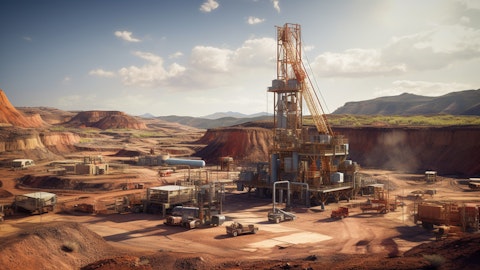Rikin Patel : Hi. Good morning. Thanks for taking my question. You covered the guidance CapEx quite well earlier, but I was wondering if you could provide some outlook on the working capital requirement for 2024. I suppose just given the context of the significant release you had last year, would you expect to see working capital investment next year? Thank you.
Bruce Bodine: Hey, Rikin thanks for joining us and appreciate the question. Working capital has been. If I understood your question right, broke up a little bit in the beginning for me, has been a focus for us across all of our major markets. I think we’ve done a pretty good job of managing that risk compared to others in the space. But I’m going to turn it over to Clint to maybe talk a little bit more about how we think about working capital.
Clint Freeland : Yes. Thanks Bruce, and thanks for the question Rikin. As you noted, over the last couple of years, we’ve seen pretty significant changes in working capital. And a lot of that has been driven by the price environment. So you saw a significant increase in working capital and use of cash in 2022. And then you’ve seen a pretty material release of cash in 2023, as a pricing environment changed. A lot of times one of the things that is also a significant contributor to that is our distribution business in Brazil, as they manage inventory levels and so forth around some of those price changes. But as we look out, I think, it’s going to be driven by the price environment. I think, we are putting some renewed focus on things like inventory turns.
And days of payables and receivables and really trying to work even harder to manage those to, again, manage the level of working capital that’s needed. The other thing that I would note is over the last couple of years, we’ve tried to set up some funding alternatives to assist us in managing through some of those seasonal, particularly seasonal elements of working capital needs. So we’ve had a number of things like an inventory lines and receivable securitization facilities put in place, when we got our rating — debt rating upgrade to BBB flat BAA2. We also set up a commercial paper facility. And what we try to do is to maintain a certain level of funding to again take away some of those seasonal moves and to reduce some of the cash drag on the company throughout the year.
So, again, focusing on those two areas. One is just the absolute level of working capital. And again, that will be dictated by price environment, but then also being — trying to be pretty thoughtful on how we fund that through the year and not just be using cash for that purpose.
Operator: Thank you. And our next question comes from Josh Spector with UBS. Please go ahead.
Josh Spector: Yes. Hi, good morning. So I wanted to follow-up on phosphate margins, specifically. I think versus most models out there pricing came in higher but gross margins were lower in the fourth quarter. So I’m just trying to square the sequential gross margin move, if we think about in gross margin per ton in the fourth quarter – or sorry, first quarter here because you’re saying the stripping margin stays high but pricing you’re guiding up $40. We talked about more volume leverage in the first quarter. So is there a way to square all these moving parts between what you did in the fourth quarter versus what you’re expecting from a gross margin per ton perspective in the first quarter? Thanks.
Bruce Bodine: Yes, Josh, thanks. I think we are seeing a little bit of expansion there. For sure, the other part is our costs aren’t going to necessarily come down as fast given the turnaround schedule I talked about earlier. So that’s still going to be a little bit of a drag. But overall, we still see those healthy realized stripping margins. You got to think about – and I’m going to turn it over to Clint in a minute maybe talk a little bit more about it but our advantaged position on ammonia and our access to low-cost sulfur really kind of differentiates us a little bit from the industry stripping margin what we get on a realized stripping margin, given that a good portion of our ammonia consumption comes from our Faustina facility in-house.
And of course, our advantage contract with CF. So we do still think stripping margins are going to be good. Gross margins realized will be good. But maybe, given the cost pressures we’re still going to see a little bit of a slowness in full recovery of that. And Clint maybe you can talk a little bit more about that.
Clint Freeland: Yes. The only thing that I would add on that around our in-house ammonia is we made – we had I guess a turnaround about 18 months ago in Louisiana around and made some investments in our converter at the facility. And it’s – as a result it’s had much higher reliability. And again, as we’ve seen the level of production that we’ve had, we’ve been able to lean on that a little bit more as a proportion of our ammonia sourcing as well as the CF contract. So we’ve been less dependent on some of the market purchases. And as a result, as an example in the fourth quarter, about 35% of our ammonia was actually sourced in-house. And again, so that’s helpful from a comparative cost standpoint. So as we go forward, as production ramps back up, overall finished product production ramps back up, we’ll need to access a little bit more on the market.
But again in this environment at this point in time, we’re getting more benefit maybe than we naturally, historically have from our in-house production of ammonia.
Operator: Thank you. This concludes today’s question-and-answer session. I’d like to turn the conference back over to Bruce Bodine for any closing remarks.
Bruce Bodine: Well, thank you, operator. To conclude our call, I’d like to reiterate our key messages for today. First, the global phosphate market as we’ve discussed is very strong and we expect favorable dynamics to continue throughout the remainder of the year. And second, potash demand is emerging and we’ve talked about that and we expect a strong rebound in global demand this year. And third, we are executing plans to optimize our operations so that we can benefit fully from strong markets, while improving Mosaic’s resilience. And finally, our capital allocation strategy is not changing. We will invest in pursuit of compelling returns and return excess cash to shareholders. So thanks everyone for joining our call today and I hope that you have a great and safe day.
Operator: Thank you, sir. This concludes today’s conference call. We thank you all for attending today’s presentation. You may now disconnect your lines and have a wonderful day.





